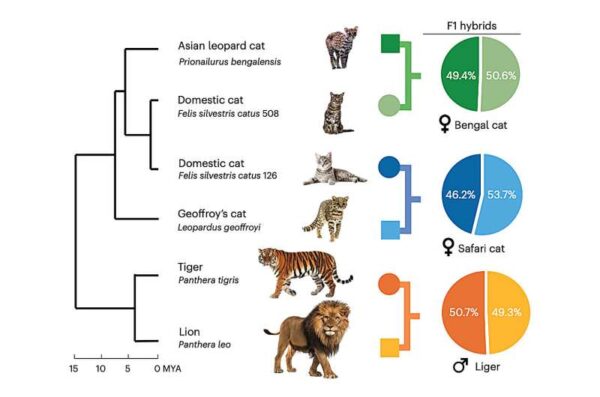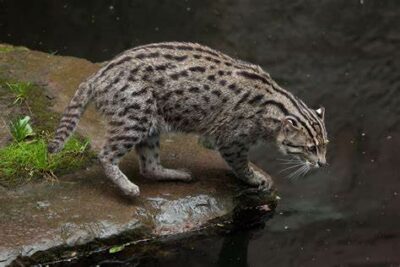Scientists keep uncovering data which reveals new secrets, this time about cat evolution. Dr. William Murphy heads up a team of researchers at Texas A&M University who have discovered new explanations about how cats have evolved into different species.

Their study includes well-known species such as lions, tigers, and also domestic cats. These discoveries reveal how different genetic changes in cats relate to survival abilities. These include, for example, the ability to smell prey.
The researchers compared genomes of several cat species. As I have a very poor knowledge of scientific terms, I had to look up “genomes” to understand what they were talking about. I learned that the genome includes the entire set of DNA instructions found in a cell. The genome contains everything the animal needs to develop and function.
I also learned that inside the nucleus of every cell are chromosomes, a thread-like structure that comprises DNA. The specific segments of DNA go by the name of genes.
Each cell of the body contains many genes, and each of these has a different function. Overall, the role of chromosomes and genes is to tell cells how to replicate. This replication informs the body how to grow and develop.
The goal of the team was to reach a better understanding as to how cats evolved, including the genetic basis of the trait differences between cat species. Interestingly, the various sets of cat chromosomes, whether from a lion or a domestic cat, hardly differ at all.
Segmental Duplications
For example, there appear to be far fewer duplications, rearrangements, or other types of variations among cat species that what one commonly finds in great apes. The key to the variations between cats and great apes is apparently the frequency of something called segmental duplications.
It has been shown that the more segmental duplications found in the DNA, the more likely the chromosomes will rearrange. By comparing cat species genomes, the discovery pointed to the fact that cat species have a fraction of the segmental duplications found in other mammal groups.
Primates actually have seven times more duplications than cats. Such a big difference causes scientists to believe that they understand why cat genomes are more stable.
Cause Of Variations Between Cat Species
Though a cat may not have as many large genetic rearrangements in their DNA as other mammals, they still can differ a great deal. Dr. Murphy and his colleagues, through research, discovered which parts of cat DNA cause the variations, especially those defining the differences between species.
They discovered that most genetic rearrangements occur in a large region on the center of the X chromosome. Dr. Murphy says, “In fact, there’s one specific repetitive element within this region called DXZ4 that evidence tells us is largely responsible for the genetic isolation of at least two cat species, the domestic and jungle cat.”

DXZ4, says Dr. Murphy, is a satellite repeat, not a typical gene that codes for a physical trait like fur color. Rather, it aids in the three-dimensional structure of the X chromosome, likely playing an important role in differing cat species.
Though the precise mechanism is not yet known, researchers find that by comparing the rate at which DXZ4 evolves in one species compared to others, they have learned that DXZ4 represents one of the most rapidly evolving parts of the cat genome, evolving faster than 99.5% of the rest of the genome.
Because of this rapid mutation rate, the team could demonstrate why DXZ4 is most likely linked to speciation.
Importance Of These New Findings
Says Dr. Murphy, “We wanted to take advantage of some new technologies that allow us to create more complete cat genomic maps. Our findings will open doors for people studying feline diseases, behavior, and conservation. They’ll be working with a more complete understanding of the genetic differences that make each type of cat unique.”
One aspect of the study revolved around a cat’s sense of smell, an ability they need to rely on the scent of their prey. Though domestic cats appear to have lost a wide range of olfactory genes, as they no longer depend so much on smelling prey, the fishing cat retains many more odorant receptors.
These cats retain many genes for detecting waterborne odorants, as they need this skill for their underwater hunting. “This trait is pretty rare in terrestrial vertebrates,” says Dr. Murphy. This cat still retains this ability as it is necessary for his survival.

Lions and tigers have a big difference between certain odorant genes which involve detecting pheromones. These chemicals become released into the environment to communicate information about identity, territory, or danger.
Lions, social animals living in family groups, may have a reduced reliance on pheromones and other odorants because they spend time around other lions. Tigers, on the other hand, have large olfactory and pheromone receptors.
Speculation on this difference involves the size of the tigers’ territories and the variety of environments in which they live.
Domestic cats, on the other hand, appear to have lost a wide range of these olfactory genes, because they don’t have to travel far to find what they need. People supply their food, thus making it unnecessary for them to preserve these genes.
Differences That Matter
One important conclusion from the project points out that cat species, though similar in many way, have differences that matter. “These differences are showing us how these animals are perfectly suited for their natural environments,” Murphy said.
“They are not interchangeable, and that’s valuable information for conservationists and others working to preserve or restore species in their natural habitats.
“For example, you can’t assume that tigers from Sumatra and Siberia are the same,” he said. “Their environments are wildly different, and those tiger populations have likely developed specialized genetic adaptations to help them survive in these very different places.”
A tool for discovering the DNA differences is called “trio binning.” This process involves taking DNA from an animal whose DNA is split 50-50 between parents of that animal and cleanly separating the maternal and paternal DNA to get two complete sets, one for each parent species.
By looking at these sets of DNA, researchers have been able to link segmental duplications to chromosoome rearrangements. The more segmental duplications in the DNA, the more likely the chromosomes are to rearrange.
An overview of basic education: Learn how cat DNA testing is processed
Dr. Murphy states, “What we discovered by comparing a large number of cat species genomes is that cats have just a fraction of the segmental duplications found in other mammal group.” Because of this big difference, researchers believe they understand why cat genomes prove more stable.
Though the cat still retains a great deal of mystery concerning his make-up, studies such as this one from the Texas A&M School of Veterinary Medicine & Biomedical Sciences (VMBS) have added some valuable information about cat evolution.
References I used for this post: vetmed.tamu.edu/news/press-releases/cat-evolution/ sciencealert.com/the-secrets-of-cat-evolution-have-finally-been-revealed phys.org/news/2023-11-genome-sequencing-reveals-secrets-cat.html#google_vignette genome.gov/genetics-glossary/Genome

